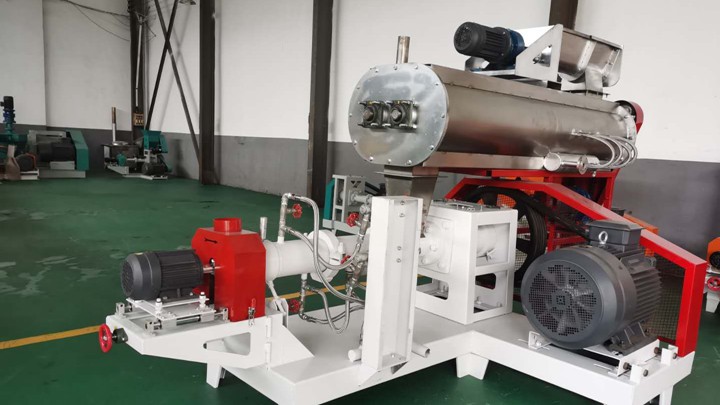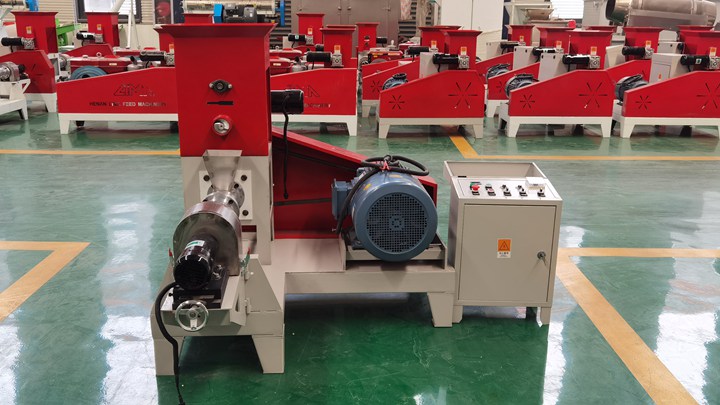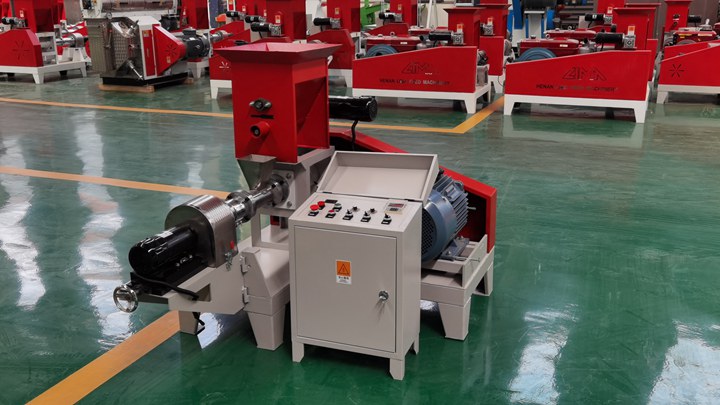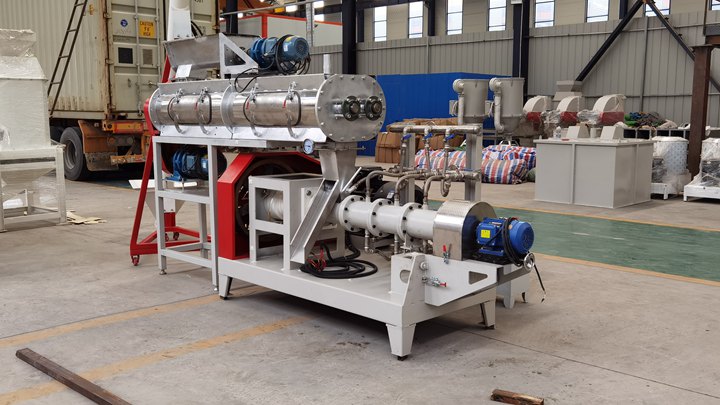feedstuff granulator for fish farms plant
-
.jpg)
Optimizing the levels of feeding stimulants for use in high
Nov 1, 2001 · Two experiments were conducted to examine the efficacy of a predetermined feeding stimulant mixture (FSM) on growth performance of striped bass fed either a high-fish meal (FM) or a plant feedstuff-based (PF) diet.
Get Price -
.jpg)
feedstuff granulator for fish farms plant- fishpelletmachine
Lima offers 281 Granulator Feed Mill Suppliers, and Granulator Feed Mill Manufacturers, Distributors, Factories, Companies. There are 124 OEM, 124 ODM, 46 Self Patent. Find high quality Granulator Feed Mill Suppliers onLima.
Get Price -
.jpg)
The use of plant by-products as non-conventional feedstuff
Jul 27, 2019 · Global warming has turned as a global concern for especially those who engaged in animal agriculture. The use of non-conventional feedstuff (e.g., plants and plant extracts) has also become an interesting topic since they are natural products, environmentally friendly and safe in food production. These potential feed additives are rich sources of secondary compounds. The ideal effects of these
Get Price -
.jpg)
300-400KG/H chicken livestock poultry cattle feed mill/animal
Max. capacity: 200-300 KG/H, Applicable industries: Hotels, Garment Shops, Building Material Shops, Manufacturing Plant, Machinery Repair 300-400KG/H chicken livestock poultry cattle feed mill/animal feedstuff pellet machine/fish shrimp poultry feed making machine in Zhengzhou, China
Get Price -
.jpg)
Feed Pellet Mill & Ancillary Feed Pelletizing Machines
The dry type fish feed extruder is of simple design and easy operation, making fish feed pellets with dia 0.9-15mm. If you have fish ponds and aquatic farms, this machine is really cost-effective to make your own fish food.
Get Price -
.jpg)
Introductory Chapter: Animal Feed Science and Nutrition
May 18, 2022 · 3. Livestock and environment. Worldwide food production systems (livestock and vegetable-origin foods) contribute 18 Gt greenhouse gas (GHG; CO 2, methane, nitrous oxide, and fluorinated gases) emissions in CO 2 equivalent (CO 2 e) (non-CO 2 gases are expressed as CO 2 e based on the warming potential of the gases) account one-third (34%) of total global GHG based on detailed life cycle
Get Price -
.jpg)
Granule Feedstuff Machine -Lima.com
Save money on feed processing machines when you shop for granule feedstuff machine atLima.com. Discover permanently low prices when you buy direct from Chinese wholesalers.
Get Price -
.jpg)
Feedstuff Sales - Plant City, FL 33563 - The Real Yellow Pages
4107 Peacock Rd, Plant City, FL 33565. Family Feed & Pet Supplies. 3669 Paul Buchman Hwy, Plant City, FL 33565. Alan Moyer Equipment. 729 E US Highway 92, Seffner, FL 33584. Farm Direct Produce Sales. 4720 Gallagher Rd, Plant City, FL 33565. Southside Stores. 3014 James L Redman Pkwy, Plant City, FL 33566. Antioch Feed & Farm Supply
Get Price -

Animal nutrition and feed rations | Infonet Biovision Home.
Pantothenic Acid: Supplementation recommended with for example rice or wheat bran, rice polishing, sunflower meal, Lucerne meal, fish- or peanut meal, brewer's yeast. Vitamin B12: This vitamin is only found in animal products such as fish meal, blood meal, or for open range pigs and poultry: insects, grubs, etc.
Get Price -

New Fish Feed Feedstuff Machine Processing Plant -Lima.com
Shop for a new fish feed feedstuff machine processing plant from a Chinese wholesaler atLima.com and find a wide selection of pet food processing machines that meets your needs.
Get Price -

Food system by-products upcycled in livestock and - Nature
Sep 19, 2022 · Food-competing feedstuff use. We first combined data from various sources, using production data for primary products for 2016–2018 (refs. 2,30) and feed composition data for livestock and
Get Price -

Soybean meal | Feedipedia
Soybean meal is the most important protein source used to feed farm animals. It represents two-thirds of the total world output of protein feedstuffs, including all other major oil meals and fish meal (Oil World, 2015).
Get Price -
.jpg)
10 FISH FEEDS AND FEEDING - Food and Agriculture Organization
1. In Section 2.0 of this manual, you have learned thatplants are able, through photosynthesis, to utilize sunlight and simple nutrients to produce new organic material. On the contrary, animals, including fish, cannot. Thus to survive, grow and reproduce, fish need to feed on organic materialssuch as plants, other animals, or prepared feeds contai See full list on fao.org Why use supplementary feeding 1. There are several reasons why you shouldsupplement the natural foods available within the pond with artificial feedstuffs originating from outside the pond, for example: 1. whennatural foods become insufficient to feed your fish well and ensure good growth; and 2. when you wishto raise more fish in your pond to produce a higher crop and still have good growth. 2. As you make more use of supplementary feeds, you change from anextensive system to a semi-intensive system of production. Selecting supplementary feeds 3. When deciding on the use of supplementary feeds on your farm and their selection, look for feedstuffs that are: 1. of good nutritional values: with high protein* and carbohydrate*content and low fibre content (see paragraphs 6 to 9); 2. well acceptedby the fish you plan to feed; 3. cheap in price:for a given food quality, the lower the cost, the better; 4. available most of the fish-growing season; 5. of minimum additional costfor transport, handling and processing; 6. easy to handle and s... Presenting supplementary feeds 10. Supplementary feedstuffs are available in two forms: dry and wet. 11.Dry feedstuffs such as cereals and cakes are easier to store, to transport and to distribute to the fish. 12. Wet feedstuffs such as blood, rumen contents, molasses and brewery wastes require special treatment before feeding, for example mixing with dry feedstuffs to absorb part of the moisture ordrying to improve storage life (see Section 10.6). 13. As a result, supplementary feeds are usually presented to fish either d... See full list on fao.org 1. You should aim at providing all the feed the fish need to: 1. maintain body functions such as blood circulation and routine respiration; and 2. grow, increasing in size and producing eggs, for example. 2. If the quantity or quality of feed available is limited, fish may not grow, may lose weight, or may even die from food deficiency. Growth will... See full list on fao.org 1. In the two previous sections, you have learned which kind and what quantities of supplementary feeds can be used. Now you should learn when, where and how to apply these feeds in your ponds. One of the basic points is to adjust distribution according to the fish size and/or age. Example Feed your fish correctly according to their age. See full list on fao.org Transporting feedstuffs 1. Feedstuffs produced outside the fish farmhave to be regularly acquired and brought close to the ponds to be stored. For large quantities, a truck is usually used to transport them, but simpler means can also be used such as animal-drawn carts or small bicycle-drawn trailers. 2. On the farm itself, feed materials are further moved around for processing (see Section 10.6) and distribution in the ponds. Over short distances, containers (such as baskets, bags or buckets) or wheelbarrows are us... Important factors during storage 4. Feedstuffs must be stored with special care to prevent excessive deterioration in quality and feed losses. The most Important factors to controlare the following. (a) Moisture content of both air and feedstuffs should be maintained as low as possible. You should try to keep the relative humidity of the air below 75 percent. (b) Temperatureof both air and feedstuffs should be kept as low as possible. At temperatures above 25�C, the rates of deterioration and loss may rapidly increase. (c) M... Improving the storage of feedstuffs 5. To reduce such deterioration and loss of feedstuffs to a minimumduring their storage on your fish farm, pay special attention to the following points. (a) Keep the storage areas asdry and coolas possible: 1. provide a good roof to protect against rainstorms and sunlight; 2. protect the floor from flooding or rising moisture (a raised concrete floor or afishen platform are best); 3. provide good ventilation through the building (it is best to have its length facing prevailing winds and cut... See full list on fao.org 1. On small-scale rural fish farms, local feedstuffs are usually given to the fish in their natural state. As the production scale increases, however, some kind of processing is often used to improve the utilization of available feedstuffs and reduce feeding costs. This may involve one or several successive operations such as grinding, sieving, mix... See full list on fao.org
Get Price -

Feedstuffs for Beef Cattle | Farms.com
Sep 4, 2019 · The bulkiness and associated storage space required for a given volume of feedstuff varies greatly among these products. Particle size and other mixing characteristics affect the flexibility of including a specific feedstuff as part of a mixed feed. On-farm feed delivery systems also determine the viability of using various feedstuffs.
Get Price -
.jpg)
Feedstuff Handling, Storage, and Feeding Systems for
Feedstuff storage, handling, and feeding characteristics affect which feedstuff is the best choice for an operation. Livestock feedstuffs include forages and grain-based and coproduct feeds. Grazed forages generally make up the bulk of livestock diets in Mississippi, but stored forages and grain-based feeds are
Get Price